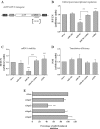Molecular basis of differential target regulation by miR-96 and miR-182: the Glypican-3 as a model
- PMID: 22009679
- PMCID: PMC3273822
- DOI: 10.1093/nar/gkr843
Molecular basis of differential target regulation by miR-96 and miR-182: the Glypican-3 as a model
Abstract
Besides the fact that miR-96 and miR-182 belong to the miR-182/183 cluster, their seed region (UUGGCA, nucleotides 2-7) is identical suggesting potential common properties in mRNA target recognition and cellular functions. Here, we used the mRNA encoding Glypican-3, a heparan-sulfate proteoglycan, as a model target as its short 3' untranslated region is predicted to contain one miR-96/182 site, and assessed whether it is post-transcriptionally regulated by these two microRNAs. We found that miR-96 downregulated GPC3 expression by targeting its mRNA 3'-untranslated region and interacting with the predicted site. This downregulatory effect was due to an increased mRNA degradation and depended on Argonaute-2. Despite its seed similarity with miR-96, miR-182 was unable to regulate GPC3. This differential regulation was confirmed on two other targets, FOXO1 and FN1. By site-directed mutagenesis, we demonstrated that the miRNA nucleotide 8, immediately downstream the UUGGCA seed, plays a critical role in target recognition by miR-96 and miR-182. Our data suggest that because of a base difference at miRNA position 8, these two microRNAs control a completely different set of genes and therefore are functionally independent.
Figures




Similar articles
-
New tumor suppressor microRNAs target glypican-3 in human liver cancer.Oncotarget. 2017 Jun 20;8(25):41211-41226. doi: 10.18632/oncotarget.17162. Oncotarget. 2017. PMID: 28476031 Free PMC article.
-
MicroRNA-1291-mediated silencing of IRE1α enhances Glypican-3 expression.RNA. 2013 Jun;19(6):778-88. doi: 10.1261/rna.036483.112. Epub 2013 Apr 18. RNA. 2013. PMID: 23598528 Free PMC article.
-
A functional screening identifies five microRNAs controlling glypican-3: role of miR-1271 down-regulation in hepatocellular carcinoma.Hepatology. 2013 Jan;57(1):195-204. doi: 10.1002/hep.25994. Hepatology. 2013. PMID: 22865282
-
HOXA-AS2 Promotes Proliferation and Induces Epithelial-Mesenchymal Transition via the miR-520c-3p/GPC3 Axis in Hepatocellular Carcinoma.Cell Physiol Biochem. 2018;50(6):2124-2138. doi: 10.1159/000495056. Epub 2018 Nov 9. Cell Physiol Biochem. 2018. PMID: 30415263
-
miRNA Targeting: Growing beyond the Seed.Trends Genet. 2019 Mar;35(3):215-222. doi: 10.1016/j.tig.2018.12.005. Epub 2019 Jan 9. Trends Genet. 2019. PMID: 30638669 Free PMC article. Review.
Cited by
-
MiRNA Regulatory Functions in Photoreceptors.Front Cell Dev Biol. 2021 Jan 21;8:620249. doi: 10.3389/fcell.2020.620249. eCollection 2020. Front Cell Dev Biol. 2021. PMID: 33553155 Free PMC article. Review.
-
Roles of miR-182 in sensory organ development and cancer.Thorac Cancer. 2015 Jan;6(1):2-9. doi: 10.1111/1759-7714.12164. Epub 2015 Jan 7. Thorac Cancer. 2015. PMID: 26273328 Free PMC article. Review.
-
New tumor suppressor microRNAs target glypican-3 in human liver cancer.Oncotarget. 2017 Jun 20;8(25):41211-41226. doi: 10.18632/oncotarget.17162. Oncotarget. 2017. PMID: 28476031 Free PMC article.
-
Inhibition of MicroRNA-182/183 Cluster Ameliorates Schizophrenia by Activating the Axon Guidance Pathway and Upregulating DCC.Oxid Med Cell Longev. 2022 Nov 10;2022:9411276. doi: 10.1155/2022/9411276. eCollection 2022. Oxid Med Cell Longev. 2022. PMID: 36406766 Free PMC article.
-
The potential of miR-183 family expression in inner ear for regeneration, treatment, diagnosis and prognosis of hearing loss.J Otol. 2017 Jun;12(2):55-61. doi: 10.1016/j.joto.2017.03.003. Epub 2017 May 3. J Otol. 2017. PMID: 29937838 Free PMC article. Review.
References
-
- Garneau NL, Wilusz J, Wilusz CJ. The highways and byways of mRNA decay. Nat. Rev. Mol. Cell Biol. 2007;8:113–126. - PubMed
-
- Grosset C, Chen CY, Xu N, Sonenberg N, Jacquemin-Sablon H, Shyu AB. A mechanism for translationally coupled mRNA turnover: interaction between the poly(A) tail and a c-fos RNA coding determinant via a protein complex. Cell. 2000;103:29–40. - PubMed
-
- Grosset C, Boniface R, Duchez P, Solanilla A, Cosson B, Ripoche J. In vivo studies of translational repression mediated by the granulocyte-macrophage colony-stimulating factor AU-rich element. J. Biol. Chem. 2004;279:13354–13362. - PubMed
Publication types
MeSH terms
Substances
LinkOut - more resources
Full Text Sources
Other Literature Sources
Research Materials
Miscellaneous

